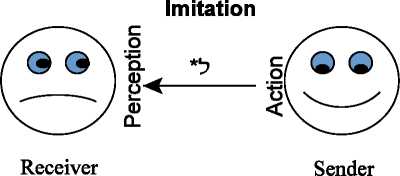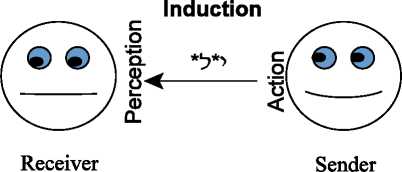inductor k, and * (yud) is the induction factor of the inductor (sender) k. We can see graphically
this idea in Figure 16.

Figure 15. Imitation of behaviour

Figure 16. Induction of behaviour
An individual with a higher value of * will have a higher probability to induce his
behaviour to others. In other words, he would be a leader (in comparison to individuals with
a lower value of *). On the other hand, individuals with low values of - will have a lower
probability of imitating other individuals or being induced by other individuals. This makes
them less social. Therefore, we can see - as a sociality parameter.
The successful imitation and induction of behaviours depend on the ASM or BPS, the
reactiveness and motivation degree of the behaviour, the internal state of the individual, and
his perceived scenario. Our model only provides the information of the behaviour executed, but
this information should go through a control process as any other information received by the
perceptual system.
We can see that with this simple model, for different values of - and * we can have a
wide variety of complex social behaviours and systems, also depending on many other
circumstances, such as the capabilities of the individuals, and the state of their environment.
4.1.1. The learning of the imitation factors
We have seen that in our I&I model the -k variables determine the strength of the
imitation of the behaviours executed by individual k. So, if we increase the -k value, the
individual will have a higher probability to imitate individual k, and if we decrease it, the
individual will have a lower probability to imitate individual k, and he will never imitate him if
the value of -k reaches zero. If -k is lesser than zero, we could say that the behaviour would
tend to be antisocial towards individual k (the imitator would be inhibited in executing the
behaviour that individual k is executing).
We will apply a simple modification criteria. First, the modification will only take place
if there are internal needs in the individual. This is based on animal behaviour, where
conditioning can only take place when there are internal needs (Pavlov, 1927). So, if the
individual has internal needs, and he is perceiving individual k, -k will be modified. If he
performs the same behaviour as the one perceived in individual k, -k will be increased. If he
performs a different behaviour, -k will be decreased. The increase and decrease formulas are
written in expressions (17) and (18).
57
More intriguing information
1. The name is absent2. Banking Supervision in Integrated Financial Markets: Implications for the EU
3. Managing Human Resources in Higher Education: The Implications of a Diversifying Workforce
4. HOW WILL PRODUCTION, MARKETING, AND CONSUMPTION BE COORDINATED? FROM A FARM ORGANIZATION VIEWPOINT
5. The Functions of Postpartum Depression
6. Estimating the Technology of Cognitive and Noncognitive Skill Formation
7. The name is absent
8. The name is absent
9. European Integration: Some stylised facts
10. The name is absent